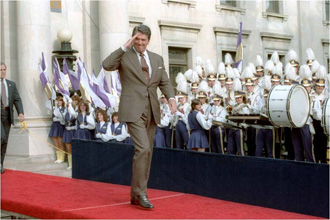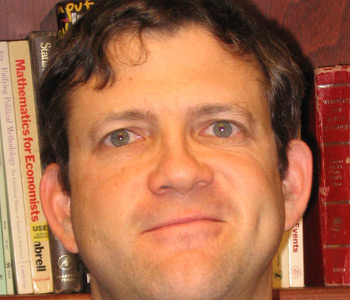David T. Courtwright
No Right Turn: Conservative Politics in a Liberal America
Harvard University Press
320 pages, 6 1/8 x 9 1/4 inches
ISBN 978 0674046771
When did America take a right turn? Most people think it began with the chaos of the 1960s, the unraveling of the New Deal coalition, the rise of the New Right, and the return of market ideology. The 1980 presidential election confirmed the conservative shift, ushering in a Republican golden age still evoked by those who claim Ronald Reagan’s mantle.
But how conservative, really, were the forty years after 1966, when liberal political power began to wane? I believe that they were not very conservative at all.
The dreams of liberalism’s enemies—to overturn the New Deal, to overturn the moral and sexual revolutions, to overturn people’s reliance on government—all went unfulfilled.
True, Republicans used wedge issues to gain power, but once in office they could not govern as reactionaries. Corporate interests, boomer lifestyles, entitlement expectations, and the media weighed too heavily against them.
The most that Republicans could achieve was selective reaction through attacks on crime, drugs, and welfare dependency—vote-rich targets magnified by racial backlash. But religious conservatives made little progress on abortion and school prayer, and steadily lost ground on obscenity, gay rights, and legalized vices like gambling. Fiscal conservatives watched in dismay as the bills mounted.
President Reagan’s mélange of big government, strong defense, lower taxes, higher deficits, mass imprisonment, crony capitalism, and patriotic symbolism proved an illusory and unsustainable form of conservatism. In the end, conservatives themselves rebelled against George W. Bush’s profligate brand of Reaganism.
If the Tea Party is any indication, their rebellion still has life in it—and is by no means aimed solely at Democrats.

<em id="">No Right Turn</em> is a historical critique of conservative politics—not an attack on conservative values.
When American historical writing entered its Humpty Dumpty phase, sometime around 1970, political and social history flew off in separate directions. In No Right Turn I bring them back together. The book could hardly do otherwise: “social issues” like permissiveness and crime moved to the center stage of American politics in the late 1960s and stayed there.
Religious conservatives waged a culture war against moral liberalization, but their campaign largely failed, thanks to Republican equivocation and corporate self-interest. There was good money in bad conduct and, besides, it was awkward to inquire too deeply into what Rupert Murdoch was beaming through his satellites or the Mormon-run Marriott chain was showing in its hotel rooms.
And how does this book compare to others? Well, think of Christopher Lasch without the grouchiness, David Stockman without the score-settling, and Thomas Frank without the mockery.
Though No Right Turn is more measured in tone than What’s the Matter with Kansas? its indictment of the GOP establishment is more sweeping. Principled economic conservatives fared almost as badly under Republicans as did the moral reactionaries. There’s more to the story than the fat cats using the yahoos.
I was surprised, or half-surprised, by my own conclusions. When I started gathering material, in the early 1980s, I suspected that the moral counterrevolution against liberalism would peter out. But I did not suspect that the economic counterrevolution would also fail. After I read Stockman’s memoirs, The Triumph of Politics, I began to think otherwise.
A remark of James Pinkerton, a domestic-policy adviser to the first President Bush, seems particularly apt. “The two things we learned in the eighties were entirely contradictory,” Pinkerton said. “Socialism doesn’t work, and the most ideological President of the twentieth century, Ronald Reagan, couldn’t put an end to the welfare state. He couldn’t even put a dent in it.” We have been living with that contradiction ever since.
Revisionist writing tends to be dry. To avoid that trap I emulated Arthur Schlesinger Jr., master of the provocative reinterpretation of an age dominated by populist politics. I fleshed out my narrative with portraits of the era’s celebrated combatants: Clare Boothe Luce, the Kennedy brothers, Barry Goldwater, Daniel Patrick Moynihan, Jerry Falwell, Ronald Reagan, Lee Atwater, Robert Bork, and Bill and Hillary Clinton.
Above all I was drawn to Richard Nixon, the key figure in American political history in the second half of the twentieth century.
Ronald Reagan strutting his stuff (Photo courtesy of the Reagan Library)

For fans of psychobiography, Nixon is the gift that keeps on giving.
Even after he reached the White House in 1969, Nixon still had to live with his ulcers and his demons. He fled them, not in the sleep denied by insomnia, but in the waking dream of omnipotence and grand achievement. He’d show them. He’d tidy up the nation’s messes, restore its prestige, enter its history as a great statesman. And God help anyone who tried to stop him.
Publicly, Nixon had campaigned to bring the nation together. Privately, he railed against the elite that scorned him. The educated, society’s natural leaders, had lost their guts, Nixon told his staff. They drank too much, parroted fashionable talk. They knocked the system and boo-hooed about the blacks, who were hopeless anyway. The Jews had the wettest hankies. A few tough ones, like Henry Kissinger, knew the score. The rest were pathetic. Permissiveness and defeatism had spread everywhere, even to the clergy. No wonder the churches were emptying out. Now the Catholics were starting down the same damn road. And look at the schools, filled with nihilism and dope. Most of the kids would be better off if they got out from behind their desks and did some honest work.
Given his right-conservative temperament, Nixon would have preferred a domestic policy aimed at reducing taxes, bureaucracy, union influence, crime, vice, spending, and the supply of money. That he did none of these things consistently, that he presided over an erratically liberal domestic policy, was due to a fateful combination of circumstances. Nixon was the first elected president in 120 years to assume office with the opposition party controlling both houses of Congress. The Democrats’ liberal allies dominated the federal bureaucracy, the national media, and the academic establishment. Collectively, they could block any reactionary shift.
Nixon therefore had to work subtly. He exploited social issues through deft gestures. He even ordered the removal of Portnoy’s Complaint, Philip Roth’s comedic novel of sexual obsession, from the White House library and then leaked the news that he had done so. But he mostly refrained from overt attacks on welfare queens and newsroom lefties. That was Spiro Agnew’s job.
Nixon did his venting in private, which was why the White House tapes were so scurrilous. He was letting his hair down with the boys–only the boys, Nixon’s prejudices fully extending to women. Yet he supported the Equal Rights Amendment and sought a conservative female Supreme Court nominee, rubbing his hands over the prospect of Senate liberals taking their law-and-order pill with a sugar-coating of feminism. He really was Tricky Dick.
Nixon’s canny posturing left a bitter legacy for Goldwater Republicans. “Buchanan,” the president once told his speech writer, “you have to give the nuts 20 percent of what they want.” Those words distill four decades of Culture War politics.
Nixon blazed a trail of tokenism through the political thicket of counterrevolution. His successors mostly followed it. Right-conservatives grew increasingly frustrated. Having nominated one of their own in 1964, having apparently elected one of their own in 1968, having surely elected one of their own in 1980, they never got a Republican administration that governed in a consistently conservative fashion, moral or, for that matter, economic. Nixon was the first in a long line of White House disappointments.

The Tea Party is as much inspired by the contemporary politics of betrayal and predation as by the idealized golden-age politics of the Founding Fathers.
No Right Turn is a historical critique of conservative politics—not an attack on conservative values.
I have nothing against sound budgets, safe streets, and stable families, the best safeguard of children’s welfare. I suspect that many battle-hardened conservatives (and, for that matter, liberals) share my belief that Republican politicians from Nixon on have used conservatism more as a means to power than a blueprint for governing.
I was struck, when I interviewed the likes of Randall Terry and Paul Weyrich, by how much they sounded like George McGovern or Michael Dukakis on the subject of GOP dissembling—and not just on moral issues like abortion.
Conservative anger over bait-and-switch tactics, which reached a boil during George W. Bush’s second term, has again become an important force in American politics. Though the book ends with Barack Obama’s 2008 election, it serves as a prologue for the Tea Party, which is as much inspired by the contemporary politics of betrayal and predation as by the idealized golden-age politics of the Founding Fathers.




We don't put paywalls. We don't distract you with ads. We don't sell your data.
Please help to keep this running!